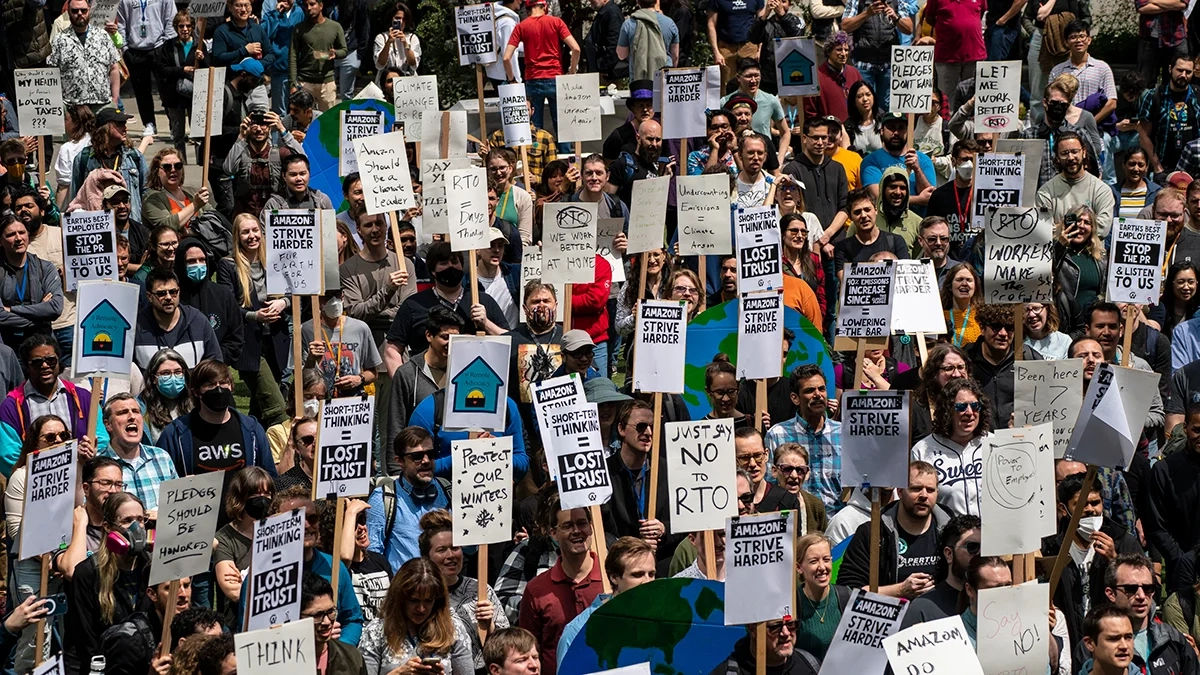On Wednesday, a group of Amazon employees staged a walkout to protest against the company’s recent return-to-office mandate, layoffs, and environmental record. The walkout was joined by around 2,000 employees from different parts of the world, with approximately 1,000 of them gathering outside the Spheres, the massive glass domes that anchor Amazon’s Seattle headquarters. The employee groups behind the effort reported that the walkout was organized in part by Amazon Employees for Climate Justice, an influential worker organization that has been continuously urging the e-retailer to take a stronger stance on climate issues.
Employees are walking out to express a “lack of trust in company leadership’s decision-making,” according to the group. Amazon recently announced the largest layoffs in its 29-year history, cutting 27,000 jobs across its cloud computing, advertising, and retail divisions, among others, since last fall. On May 1, the business directed corporate staff to begin working from the office at least three days per week, thereby ending the remote work arrangements that some employees had developed during the coronavirus outbreak.
Workers gathered on a green park surrounded by office towers and next to an airstream distributing free bananas to office goers, holding placards reading “Amazon strive harder” and “Earth’s best employer?” Stop the PR and listen to us.” One employee mentioned how remote work allowed her to spend more time with her family, while coworkers said it helped them to care for newborn infants and relatives with special needs.
“Today looks like it might be the start of a new chapter in Amazon’s history when tech workers coming out of the pandemic stood up and said we still want a say in this company and the direction of this company,” said Eliza Pan, cofounder of AECJ and former Amazon program manager. “We still want a say in important decisions that affect all of our lives, and tech workers are going to stand up for ourselves, for each other, for our families, for the communities where Amazon operates, and for life on planet Earth.”
According to Amazon, approximately 300 employees took part in the walkout. Amazon employees are walking off the job at a critical juncture in the company’s history. Amazon has barely completed its layoffs, and it is still dealing with the tough economy and decreasing retail sales, leaving employees on their way to future layoffs.
Amazon employees staged a walkout to protest the company’s return-to-office mandate, layoffs, and environmental record, with workers urging CEO Andy Jassy and the S-team to drop the mandate, citing its inconsistency with Amazon’s values on diversity, inclusion, sustainability, and being the “Earth’s Best Employer.” The return-to-office mandate has raised concerns among employees who moved during the pandemic or were hired for remote roles, particularly those outside of Amazon’s key tech hubs, and employees are also calling attention to the company’s failure to meet its climate commitments. Despite this, Amazon reports increased energy, collaboration, and connections among employees as they work towards a smooth transition back to the office.
Furthermore, Amazon recently dropped one of its sustainability objectives, Shipment Zero, in which the corporation pledged to make half of all shipments carbon neutral by 2030. Amazon stated that it would concentrate on its broader Climate Pledge, which includes a pledge to achieve net-zero carbon emissions by 2040, a decade later than its original Shipment Zero commitment.
“Our goal is to change Amazon’s cost/benefit analysis on making harmful, unilateral decisions that are having an outsized impact on people of color, women, LGBTQ people, people with disabilities, and other vulnerable people,” the group said.
Glasser stated that Amazon is “pushing hard” to achieve net carbon zero across its operations by 2040. He noted that the corporation is still on target to achieve 100% renewable energy by 2025. “While we all would like to get there tomorrow, for companies like ours who consume a lot of power, and have very substantial transportation, packaging, and physical building assets, it’ll take time to accomplish,” Brad Glasser added.




